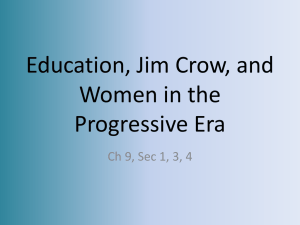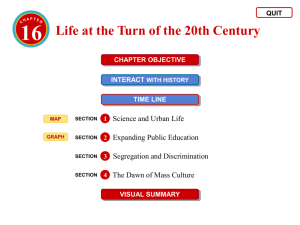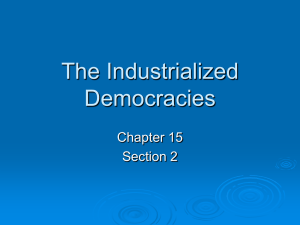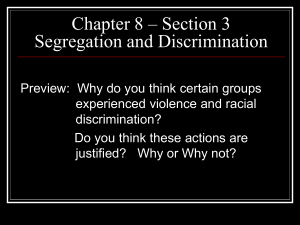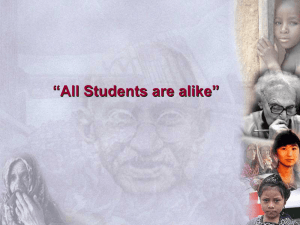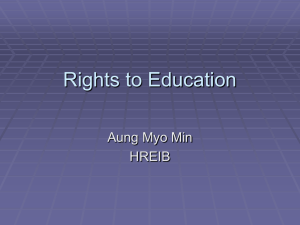CH08Pres
advertisement
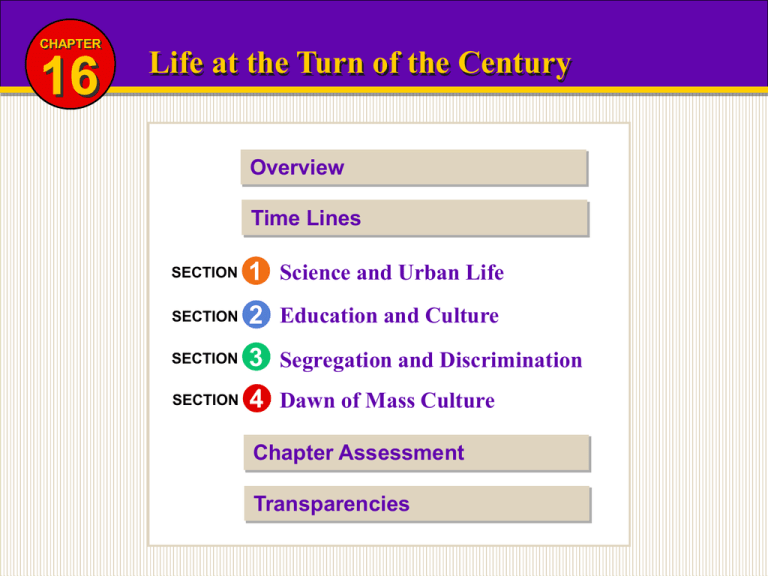
CHAPTER 16 Life at the Turn of the Century Overview Time Lines SECTION 1 Science and Urban Life SECTION 2 Education and Culture SECTION 3 Segregation and Discrimination SECTION 4 Dawn of Mass Culture Chapter Assessment Transparencies CHAPTER 16 Life at the Turn of the Century “Every nation should be judged by the best it has been able to produce, not by the worst.” James Weldon Johnson, lawyer and writer THEMES IN CHAPTER 16 Science and Technology Immigration and Migration Civil Rights Women in America HOME CHAPTER 16 Life at the Turn of the Century “Every nation should be judged by the best it has been able to produce, not by the worst.” James Weldon Johnson, lawyer and writer What do you know? • What do you already know about American life a hundred years ago? How did Americans work and play? What new inventions were changing people’s ways of life? Read the quote above and answer the following: • Do you agree with the quotation? Why or why not? • If you applied the quotation to America today, what would you offer as the best or worst? HOME CHAPTER 16 Time Line The United States 1879 F.W. Woolworth opens his “five-and-ten-cent” store. 1883 Construction of the Brooklyn Bridge is completed. 1884 Mark Twain publishes The Adventures of Huckleberry Finn. 1891 Ida B. Wells crusades against lynching. James Naismith invents basketball. 1903 The Wright Brothers successfully complete the first airplane flight. W.E.B. Du Bois publishes The Souls of Black Folk. 1915 D.W. Griffith’s epic film, The Birth of a Nation, is released. HOME CHAPTER 16 Time Line The World 1882 Triple Alliance between Italy, Austria-Hungary, and Germany is formed. 1884 A 14-nation conference on the division of Africa is held in Berlin. 1894 The African nation of Uganda becomes a British protectorate. 1900 German psychoanalyst Sigmund Freud publishes The Interpretation of Dreams. 1904 Russo-Japanese War breaks out. 1910 Japan annexes Korea. 1914 World War I begins in Europe. HOME SECTION 1 Science and Urban Life HOME Learn About developments in architecture, transportation, and communication. To Understand how technological changes at the turn of the century affected American cities. SECTION 1 Science and Urban Life Key Idea Advances in science and technology address urban problems, including lack of space and inadequate systems of transportation and communication. HOME SECTION 1 Science and Urban Life HOME Section 1 Assessment SUMMARIZING What are three examples of urban changes for each of the following topics? Suspension bridges City Design Skyscrapers Urban planning Street cars Urban Transportation Commuter trains Subways Web-perfecting press Communications Linotype machine Photography SECTION 1 Science and Urban Life Section 1 Assessment FORMING OPINIONS Which development in science and technology described in this section had the greatest impact on American culture? THINK ABOUT • short-term and long-term effects of each development • how each development affected the attitudes and lives of people at the time HOME SECTION 1 Science and Urban Life Section 1 Assessment SYNTHESIZING If you had been an urban planner at the turn of the century, what new ideas would you have included in your plan for the ideal city? THINK ABOUT • Olmsted’s plans for Central Park and the Fenway in Boston • Burnham’s ideas for Chicago • the concept of the garden city HOME SECTION 2 Education and Culture HOME Learn About changes in education and the promotion of high culture. To Understand how these developments affected America’s changing identity. SECTION 2 Education and Culture Key Idea The impulses of moral uplift and economic necessity spur changes in education, a rise in national literacy, and the promotion of high culture. HOME SECTION 2 Education and Culture HOME Section 2 Assessment SUMMARIZING What were some major educational developments from the turn of the century and what were their results? DEVELOPMENT RESULT Compulsory education laws Literacy increased. Increase in the number of kindergartens Immigrants became “Americanized.” Growth of high schools College enrollments increased. Discrimination against African Americans All-black colleges founded. New curricula Led to advances in science and medicine. SECTION 2 Education and Culture Section 2 Assessment DEVELOPING HISTORICAL PERSPECTIVE Compare the impact of museums, libraries, and other cultural institutions on early-20th-century society with their impact on today’s society. THINK ABOUT • the audience museums and libraries reached then and now • the role of museums and libraries in modern mass culture then and now HOME SECTION 2 Education and Culture Section 2 Assessment HYPOTHESIZING How might the economy and culture of the United States have been different without the expansion of public schools? THINK ABOUT • the goals of public schools and whether those goals have been met • why people supported expanding public education • the impact of public schools on the development of private schools HOME SECTION 3 Segregation and Discrimination Learn About racial tensions in the late 19th century. To Understand the persistence of racial discrimination in America. HOME SECTION 3 Segregation and Discrimination Key Idea African Americans lead the fight against institutionalized racism in the form of voting restrictions and Jim Crow laws. HOME SECTION 3 Segregation and Discrimination HOME Section 3 Assessment SUMMARIZING What people, places, legal issues, and events related to discrimination at the turn of the century? Legal Issues • • • • • People • Ida B. Wells • Booker T. Washington • W.E.B. Du Bois Literacy tests Poll tax Jim Crow laws Segregated schools Plessy v. Ferguson RACIAL DISCRIMINATION Places • The Southwest (Mexican peonage) • California (the Chinese) Events • Lynchings • Wells’s anti-lynching campaign SECTION 3 Segregation and Discrimination Section 3 Assessment 3 IDENTIFYING PROBLEMS Explain how segregation and discrimination affected the lives of African Americans at the turn of the century. HOME SECTION 3 Segregation and Discrimination Section 3 Assessment CONTRASTING How did the challenges and opportunities for Mexicans in the United States differ from those of African Americans? THINK ABOUT • the type of work each group did • the wages paid to each group • the effects of government policies on each group HOME SECTION 4 Dawn of Mass Culture Learn About transformations in leisure activities, shopping, and advertising. To Understand the emergence of modern mass culture. HOME SECTION 4 Dawn of Mass Culture Key Idea Americans have more time for leisure activities and a modern mass culture emerges, especially through newspapers and retail advertising. HOME SECTION 4 Dawn of Mass Culture HOME Section 4 Assessment SUMMARIZING What are some of the ways that leisure time and shopping changed as modern mass culture emerged? Amusement parks Bicycling Vaudeville Movies Modern mass culture emerges. Mail-order catalogs Department stores Advertising Shopping centers SECTION 4 Dawn of Mass Culture Section 4 Assessment SYNTHESIZING Write an advertisement for one of the leisure activities described in this section. THINK ABOUT • the audience you are trying to appeal to • the image you want to create • the place or publication in which your advertisement will appear HOME SECTION 4 Dawn of Mass Culture Section 4 Assessment FORMING OPINIONS Do you think the publication of sensational stories in newspapers is justified? Why or why not? THINK ABOUT • the reasons Hearst and Pulitzer included those stories • the effect that adding sensational stories had on the newspapers’ circulation • the purpose that you believe newspapers should serve HOME Chapter 16 Assessment 1. How did new technology promote urban growth around the turn of the century? 2. In what ways did methods of communication improve in the late 19th and early 20th centuries? 3. How did public schools change during the late 19th century? 4. Why did some immigrants oppose sending their children to public schools around the turn of the century? 5. How were the paintings of Thomas Eakins and the literature of Mark Twain similar? HOME Chapter 16 Assessment 6. In what ways was racial discrimination supported by federal government actions and policies? 7. How did Mexicans help make the Southwest prosperous in the late 19th century? 8. Why did a mass culture develop in the United States in the late 19th century? 9. What leisure activities flourished at the turn of the century? 10. What innovations in retail methods changed how Americans shopped during this time period? HOME



